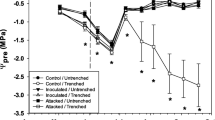Abstract
Environmental stresses, particularly water deficit, predispose eucalypt trees to attack by the eucalyptus longhorned borer, Phoracantha semipunctata F. (Coleoptera: Cerambycidae). Our experiments with potted eucalypts revealed that reduced tree water potential was associated with lower resistance to colonization by neonate P. semipunctata, but the linear relationship between water potential and colonization success was reversed at higher larval densities. There was no indication that the bark exudate “kino” served to defend trees from borer attack. Larvae were not able to colonize the cambium of eucalypt logs with high bark moisture, and survival was low under high moisture conditions in artificial hosts composed of pure cellulose. In trees and cut logs with moist bark, larvae failed to reach the cambium, feeding instead in poorer-quality tissues just beneath the bark surface. Our findings suggest that variation in resistance of eucalypts to attack by the borer is associated with moisture content of the bark.
Similar content being viewed by others
Author information
Authors and Affiliations
Additional information
Received: 2 September 1998 / Accepted: 8 January 1999
Rights and permissions
About this article
Cite this article
Hanks, L., Paine, T., Millar, J. et al. Water relations of host trees and resistance to the phloem-boring beetle Phoracantha semipunctata F. (Coleoptera: Cerambycidae). Oecologia 119, 400–407 (1999). https://doi.org/10.1007/s004420050801
Issue Date:
DOI: https://doi.org/10.1007/s004420050801




